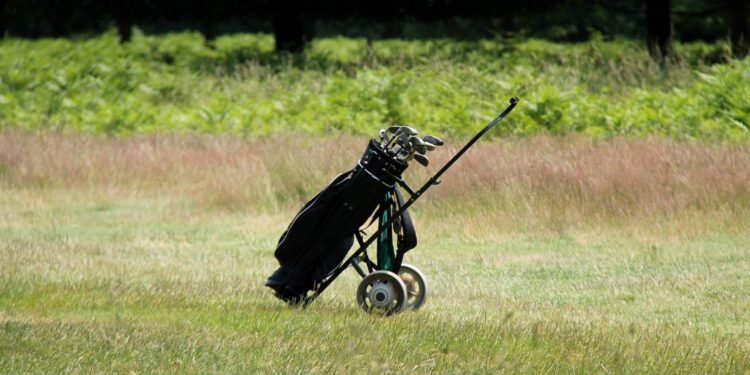Introduction
The traditional image of golf involves either striding across fairways carrying a bag on your shoulder or pushing a manual trolley up undulating terrain—both approaches requiring significant physical effort that can detract from the game itself. Yet a quiet revolution has transformed how golfers navigate courses, with electric golf trolleys emerging as the preferred choice for players who recognize that conserving energy for actual shot-making delivers better performance and greater enjoyment than exhausting yourself between shots. These battery-powered companions have evolved from basic motorized carts into sophisticated systems offering remote control operation, GPS integration, distance measurement, and intelligent course navigation. What was once considered a luxury for older players or those with mobility limitations now represents the sensible choice for golfers of all ages and abilities who understand that arriving at each shot fresh and focused rather than fatigued and distracted leads to lower scores and more pleasurable rounds. The technology has matured, prices have become increasingly accessible, and the practical benefits—from reduced physical strain to improved pace of play—make compelling arguments for anyone still manually pushing or carrying their clubs around 18 holes.
The Evolution of Golf Trolley Technology
From Manual Push Carts to Powered Assistance
Golf trolleys began as simple two-wheeled carts requiring constant pushing and pulling, offering marginal improvement over carrying bags while still demanding continuous physical effort. Three-wheeled designs improved stability and maneuverability but remained manually powered. The introduction of electric motors transformed the category entirely, eliminating the pushing effort while maintaining the walking aspect that distinguishes golf from riding in motorized carts—preserving the exercise benefits while removing the burden.
Modern Features and Capabilities
Today’s electric trolleys bear little resemblance to early models. Lithium batteries provide extended range with minimal weight, remote controls allow hands-free operation from distances of 30+ meters, integrated GPS systems display hole layouts and distances, USB charging ports keep devices powered, and smartphone connectivity enables advanced features. Some models even incorporate automatic course following, tracking your position and navigating independently while you focus entirely on your game.
Addressing Early Concerns and Limitations
Initial electric trolley skepticism centered on weight, battery life, reliability, and cost. Modern designs have systematically addressed each concern: lithium batteries weigh far less than early lead-acid alternatives while providing superior range, build quality has improved dramatically, and competitive markets have driven prices down to levels accessible for recreational players. What once represented risky investments in emerging technology now constitutes proven, reliable equipment.
Compelling Benefits of Electric Trolley Use
Preserving Energy for Better Performance
Golf rounds span 6-8 kilometers of walking, often across hilly terrain, while carrying or pushing 10-15 kilograms of equipment.

This physical demand accumulates throughout rounds, with fatigue degrading swing mechanics, decision-making, and putting touch—particularly on back nine holes. Electric trolleys eliminate this burden, allowing you to arrive at each shot fresh and focused rather than tired and distracted, directly improving performance throughout entire rounds.
Reducing Physical Strain and Injury Risk
Pushing heavy trolleys up hills, lifting bags on and off carts, and the repetitive stress of carrying bags strain backs, shoulders, and joints. These chronic stresses can lead to injuries that sideline golfers or create ongoing discomfort. Electric trolleys virtually eliminate these physical demands, making golf more sustainable as a lifetime activity while reducing injury risk that could force breaks from the game.
Improving Pace of Play
Electric trolleys maintain consistent walking speeds regardless of terrain, helping groups keep pace with course flow. You’re never delayed catching your breath after steep climbs or struggling with equipment, and remote control operation allows positioning trolleys optimally without extra steps. Many courses report that rounds with electric trolleys progress more efficiently than those with manual equipment, benefiting all players on the course.
Weather and Course Condition Advantages
In wet conditions, electric trolleys navigate soft ground more effectively than manual alternatives through powered traction and better weight distribution. Remote control allows positioning trolleys away from play lines without walking through muddy areas. In hot weather, eliminating pushing effort reduces heat stress and dehydration risk. Across all conditions, electric assistance makes golf more comfortable and enjoyable.
Key Features to Consider When Selecting Electric Trolleys
Battery Technology and Range
Lithium batteries represent the current standard, offering excellent power-to-weight ratios, consistent performance throughout discharge cycles, longer lifespans than lead-acid alternatives, and faster charging. Quality lithium batteries provide 27-36 hole ranges—adequate for most golfers’ needs even accounting for hilly courses and multiple rounds between charges. Consider battery capacity relative to your typical usage patterns and course terrain.
Remote Control vs. Manual Operation
Basic electric trolleys require walking behind them, using handlebar-mounted controls. Remote control models—operated via handheld devices—allow positioning trolleys ahead while you walk directly to your ball, reducing unnecessary steps. This hands-free convenience proves particularly valuable on courses with significant elevation changes or when playing in groups where you’re frequently waiting for others. The added cost of remote operation delivers substantial convenience benefits.
Wheel Configuration and Terrain Handling
Three-wheel designs offer superior maneuverability, navigating tight spaces and turning sharply with minimal effort. Four-wheel models provide enhanced stability on slopes and uneven ground. Consider your typical courses’ characteristics—tight, tree-lined layouts favor maneuverability, while hilly or rough terrain benefits from stability. Quality models in both configurations perform excellently; the choice largely reflects personal preference and course conditions.
Weight and Portability
Despite motorized assistance during play, you’ll still need to lift trolleys into and out of car boots. Lighter models—particularly those with lithium batteries—simplify transportation significantly. Some designs offer quick-folding mechanisms reducing packed dimensions, while others prioritize durability through heavier construction. Balance portability needs against build quality and feature preferences when selecting models.
Additional Features and Technology Integration
Modern electric golf trolleys increasingly incorporate sophisticated features: integrated GPS displays showing hole layouts and distances, USB charging ports powering phones and devices, automatic speed adjustment sensing terrain and maintaining consistent pace, scorecard holders and drink holders, and smartphone apps enabling firmware updates and performance tracking. Determine which features genuinely enhance your experience versus those representing unnecessary complexity and cost.
Understanding Total Cost of Ownership
Initial Investment Considerations
Electric trolley prices range from £300 for basic models to £1,500+ for premium offerings with advanced features. While representing significant purchases, consider the cost relative to other golf investments and potential alternatives. Riding carts cost £15-25 per round—electric trolleys pay for themselves within 20-40 rounds through eliminated rental fees while providing ongoing use for years.
Battery Replacement and Maintenance Costs
Lithium batteries typically last 5-7 years or 500+ charging cycles before requiring replacement, with replacements costing £100-200 depending on capacity. This represents the primary ongoing cost, though annual servicing (cleaning, lubrication, safety checks) may add £30-50 if performed professionally rather than as DIY maintenance. Overall, operating costs remain modest relative to the equipment’s utility and lifespan.
Comparing Value Against Alternatives
Carrying bags costs nothing beyond the bag purchase but extracts physical tolls potentially leading to injuries or shortened playing careers. Manual trolleys cost £50-150 but still require significant pushing effort. Riding carts eliminate walking entirely—removing golf’s exercise benefits—while costing substantially over time. Electric trolleys balance all factors, preserving walking’s health benefits while eliminating equipment burden at one-time costs that prove economical over multi-year ownership.
Practical Usage Tips and Best Practices
Maximizing Battery Life and Performance
Charge batteries fully before rounds and avoid complete discharge, store batteries partially charged (50-70%) during extended non-use periods, keep battery contacts clean, and avoid extreme temperature storage. These simple practices extend battery lifespan significantly. During rounds, use appropriate speed settings for conditions rather than always using maximum power—moderate speeds on flat terrain preserve battery while still eliminating effort.
Safe Operation on Courses
Position trolleys away from greens and tee boxes preventing surface damage, avoid wet or soft areas where wheels could create ruts, engage brakes on slopes when stopping, and maintain awareness of other players when using remote control—ensure trolleys don’t cross play lines or approach others unexpectedly. Responsible operation maintains course conditions while ensuring safety for all golfers.
Transport and Storage Considerations
Secure trolleys properly during vehicle transport preventing movement that could damage equipment, remove batteries during extended storage protecting both trolley and battery longevity, clean wheels and chassis after wet rounds preventing debris buildup, and store in dry locations avoiding moisture exposure. These basic precautions ensure equipment remains in excellent condition for years.
Winter and Adverse Condition Use
Many electric trolleys perform admirably in winter conditions, though consider that cold temperatures slightly reduce battery capacity. Clean thoroughly after use in wet or muddy conditions, dry completely before storage, and store batteries indoors where temperatures remain moderate. Some golfers maintain basic manual trolleys as winter backups, while others use electric trolleys year-round with appropriate maintenance.
Addressing Common Concerns and Misconceptions
“Electric Trolleys Are Only for Older Golfers”
This outdated perception ignores performance benefits applicable to all ages. Professional caddies have always carried bags precisely because players recognize that conserving energy improves play. Electric trolleys provide similar benefits—arriving at shots fresh rather than fatigued—regardless of age. Young, fit players gain identical performance advantages by eliminating unnecessary physical burden between shots.
“They’re Too Complicated and Unreliable”
Modern electric trolleys from reputable manufacturers prove remarkably reliable through improved design, quality components, and mature technology. Controls are intuitive—most models require merely turning on and adjusting speed. Maintenance demands remain minimal—periodic cleaning and annual servicing keep them operating perfectly. Technical reliability concerns that may have been valid for early models no longer apply to current equipment.
“I’ll Miss the Exercise from Carrying or Pushing”
Walking 6-8 kilometers provides excellent cardiovascular exercise whether you’re carrying, pushing, or using electric assistance. The walking itself—not the equipment burden—delivers health benefits. Electric trolleys preserve all walking benefits while eliminating the joint stress and muscle strain that can lead to injuries preventing golf entirely. You maintain fitness while protecting long-term playing ability.
“They Slow Down Play”
Evidence suggests the opposite—electric trolleys maintain consistent pace regardless of terrain, groups never wait for players catching their breath after climbs, and remote operation allows positioning equipment efficiently. Many courses encourage electric trolleys specifically because they improve pace of play compared to manual alternatives requiring extra time and effort on challenging terrain.
FAQ Section
Q: How long do electric trolley batteries typically last per charge?
A: Quality lithium batteries provide 27-36 hole capacity—adequate for most golfers’ needs. Actual range varies with terrain (hilly courses demand more power), trolley load weight, temperature (cold reduces capacity slightly), and how aggressively you use power settings. Most golfers find they charge batteries every 2-3 rounds, with full charges taking 4-8 hours depending on capacity and charger specifications.
Q: Can I use electric golf trolleys on all courses?
A: Most courses welcome electric trolleys, though some may restrict motorized equipment during extremely wet conditions to protect course surfaces, or may designate cart-path-only policies during vulnerable periods. Check with courses regarding their policies—the vast majority permit electric trolley use year-round with occasional condition-based restrictions. Private clubs may have specific rules worth understanding before purchasing.
Q: Are electric trolleys difficult to transport in regular cars?
A: Most electric trolleys fold to compact dimensions fitting easily in typical car boots. Lithium battery models are particularly manageable due to reduced weight compared to older lead-acid designs. Some models offer quick-fold mechanisms collapsing in seconds, while others require removing batteries and wheels—slightly more involved but still straightforward. Consider your vehicle’s boot dimensions when selecting models.
Q: What maintenance do electric trolleys require?
A: Minimal maintenance keeps electric trolleys operating reliably: clean after wet or muddy rounds, lubricate wheels and moving parts periodically, keep battery contacts clean, charge batteries appropriately, and consider annual professional servicing checking electrical systems and mechanical components. These simple practices ensure years of trouble-free operation without requiring technical expertise or specialized tools.
Q: Is the remote control feature worth the extra cost?
A: Remote control capability adds £150-300 to trolley costs but delivers substantial convenience through hands-free operation. You can position trolleys ahead while walking directly to your ball, control trolleys from 30+ meters away, and eliminate handlebar contact entirely. Many golfers consider this their favorite feature after experiencing the freedom it provides. If budget permits, remote control represents worthwhile investment for most players.

Conclusion
Electric golf trolleys have transitioned from niche luxury items to mainstream equipment recognized for delivering tangible performance benefits, improved enjoyment, and long-term playing sustainability. The technology has matured beautifully, modern models prove reliable and feature-rich, and prices have become increasingly accessible for recreational players. Perhaps most importantly, the fundamental premise—that conserving physical energy between shots allows better focus and execution during actual play—holds true regardless of age, fitness level, or playing ability. Whether you’re currently carrying your bag, pushing a manual trolley, or simply considering how to enhance your golf experience, electric trolleys deserve serious consideration as investments that pay dividends through improved performance, reduced physical strain, and enhanced enjoyment throughout rounds and across your entire playing career. The question isn’t really whether electric trolleys improve the golfing experience—they demonstrably do—but rather which model best suits your specific needs, preferences, and budget.









